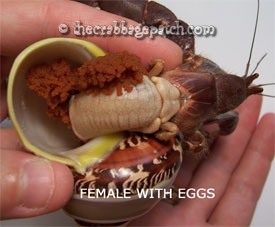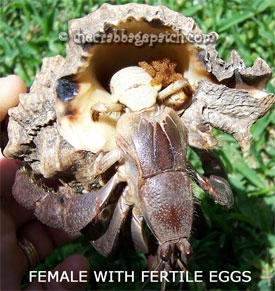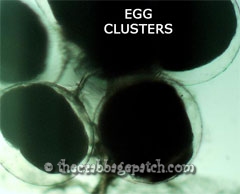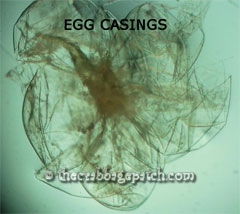|
THE LIFE CYCLE OF COENOBITA CLYPEATUS Hermit crabs can live 40+ years. They begin their life in the ocean then adapt to live the rest of their life on land.
She will carry her eggs as they mature for approximately 1 month during which time the eggs will change from brick red to a dark gray in color as the embryos deplete their yolk supply. The female will hatch her eggs in the ocean by passing clusters of eggs from her pleopods using her gill grooming appendages to her maxillipeds and forming clusters that are then passed to the tip of the claws and flung out to sea.
The eggs immediately burst upon contact with salt water and the new larval hatchlings referred to at this stage as zoeae float amongst the plankton. Each zoea will pass through 4-6 different stages lasting somewhere between 40-60 days until it eventually metamorphosis's into a megalopa which looks like a combination between a hermit crab and lobster. At the end of Since I kept my pet hermit crabs in a large 8x8x6 outdoor cage in South Florida with the ability to bury underground into sandy soil when they needed to molt, I was lucky enough to have several "pregnant" female crabs during that time. When I discovered my first female with eggs, I set up a salt water fish tank immediately using live coral rock in anticipation of hatching day under a month away. Not knowing much about salt water fish tanks, I had hoped that by using live rock I could shorten the normal cycle time for my tank.
As the weeks progressed, I watched her eggs turn from a brick red to gray color. Finally, when the eggs were a dark gray I decided to try and hatch them. I carefully dipped her shell to fill it with salt water while trying not to get her wet. I gently gyrated her shell and immediately eggs began to rupture and zoea were swimming within her shell water. I carefully poured the recently hatched zoea off into the tank and continued the process until most of her eggs had hatched. Unfortunately, each day my living zoea dwindled in number until finally on the 10th day I didn't see a single live one left. I didn't get to hatch my When we moved to Central Florida, I took a trip down to the Florida Keys. I was in a gift shop showing a family how to tell a female hermit crab from a male, when I spotted a female with eggs! The owner of the shop gave her to me so that I could attempt to hatch her eggs. Once again, I wasn't prepared with a tank that was set up and cycled. Since my crabs were now in an indoor cage in Central Florida and all of the experts agree that hermit crabs won't breed in captivity I wasn't expecting to have the opportunity again. Once again, I set up my tank using live rock and live sand this time as well. I hatched her babies and they also only lived for about 10 days. At least this time, I was able to bring samples of eggs, empty egg cases and zoea that had died down to visit Dr. John Osborne, a Biology Professor at the University of Central Florida who was kind enough to photograph my specimens under a microscope.
I realize that I made several mistakes. Since this whole thing had happened unexpectedly, I didn't have a salt Now that I have my business and an abundance of female hermit crabs, I am anticipating this coming breeding season. I will be prepared and have learned from my earlier mistakes. One of my goals with The Hermit Crab Patch is to start a captive breeding program in hopes that someday I won't have to rely on hermit crabs that have been taken from the wild. Be sure to check back with me during the summer months of July and August to see if my 3rd attempt to hatch baby hermit crabs is a success! If I am lucky enough to again have females with eggs I will document the progress on the web site under its own heading of "captive breeding". |
 Mating between hermit crabs occurs when a spermatophore is transferred by a male to the female as both crabs partially emerge from their shells. Depending on the size of the female crab, thousands of eggs are laid and deposited with the aid of the gill grooming appendages on her pleopods along the left side of her abdomen.
Mating between hermit crabs occurs when a spermatophore is transferred by a male to the female as both crabs partially emerge from their shells. Depending on the size of the female crab, thousands of eggs are laid and deposited with the aid of the gill grooming appendages on her pleopods along the left side of her abdomen.
 this stage which is thought to last about a month, the larva will find its first mollusk shell and begin to spend longer periods out of the water until eventually the megalopa buries to molt and resurfaces as a juvenile crab now fully able to survive on land. At this point, the tiny hermit crab's modified gills have adapted to breathe air and if submerged indefinitely in water, will drown.
this stage which is thought to last about a month, the larva will find its first mollusk shell and begin to spend longer periods out of the water until eventually the megalopa buries to molt and resurfaces as a juvenile crab now fully able to survive on land. At this point, the tiny hermit crab's modified gills have adapted to breathe air and if submerged indefinitely in water, will drown.
 second female's eggs the next breeding season because she ended up dropping them. Apparently I was just too late. We moved the next Spring and my tank had to be disassembled and went into storage for awhile.
second female's eggs the next breeding season because she ended up dropping them. Apparently I was just too late. We moved the next Spring and my tank had to be disassembled and went into storage for awhile.
 water tank set up, cycled and ready to go and that immediately put me at a disadvantage. Live coral rock I later found out still has to have a certain amount of time to cycle in a new tank. Also, my tank is an Eclipse which has an intake filter. I bought a very fine Micron mesh net to try and prevent zoea from being sucked up into the intake filter and they still ended up plastered to the net. Finally, I probably overfed my hundreds of zoea which at the first stage may not have even been able to eat yet at all and which contributed to high ammonia levels as the rotifer and spirulina began to decompose.
water tank set up, cycled and ready to go and that immediately put me at a disadvantage. Live coral rock I later found out still has to have a certain amount of time to cycle in a new tank. Also, my tank is an Eclipse which has an intake filter. I bought a very fine Micron mesh net to try and prevent zoea from being sucked up into the intake filter and they still ended up plastered to the net. Finally, I probably overfed my hundreds of zoea which at the first stage may not have even been able to eat yet at all and which contributed to high ammonia levels as the rotifer and spirulina began to decompose.